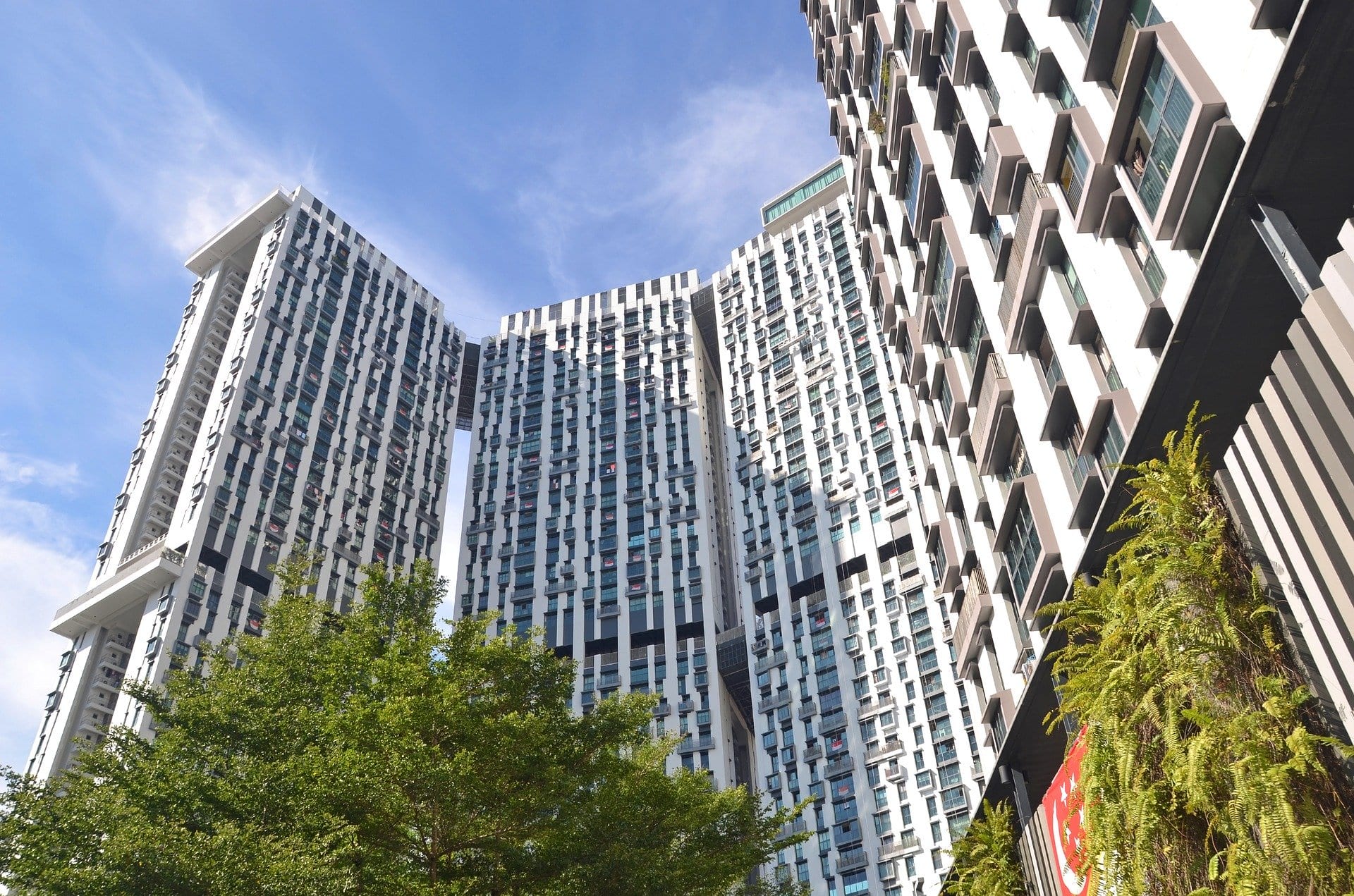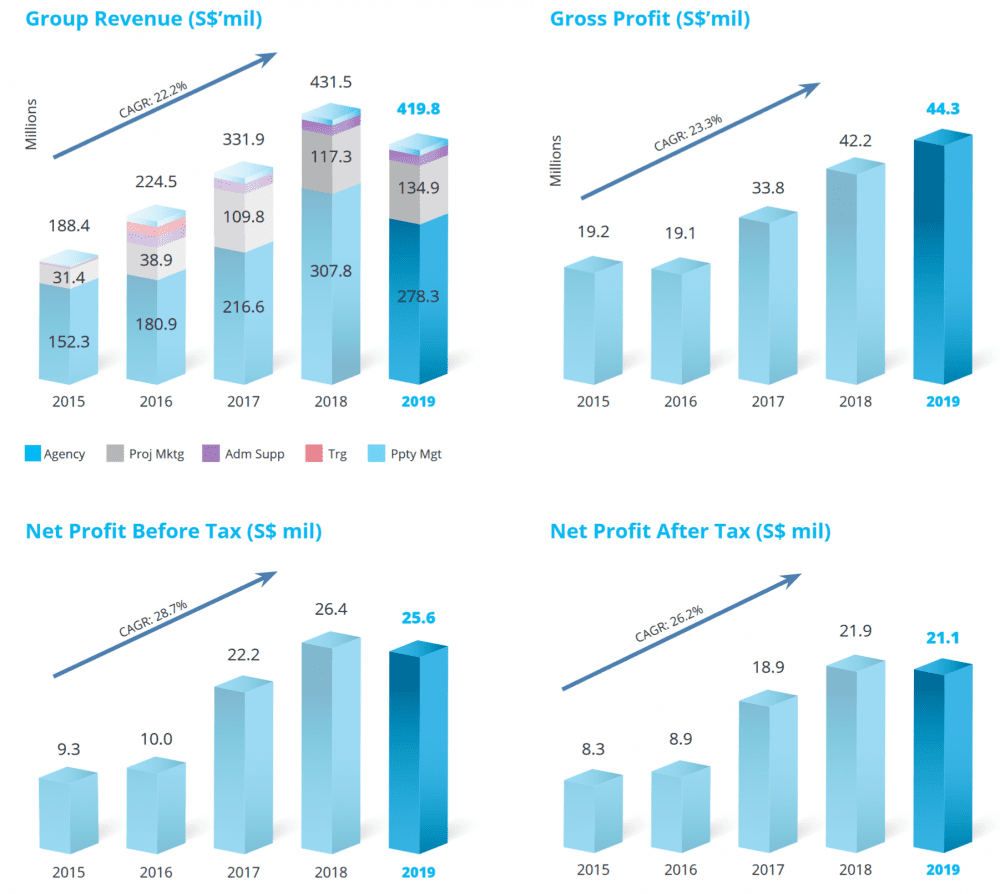
PropNex is Singapore’s largest listed real estate agency with 8,595 property agents as of 14 June 2020. The bulk of its revenues come from its real estate brokerage services, where revenue is derived through commission-based fees from sales and rental of residential, commercial, and industrial properties. Its other business segments include training services, property management services, and real estate consultancy.
From the chart below, PropNex’s revenue breakdown in FY2019 does not vary too much across different real estate segments:

Source: PropNex 2020 AGM presentation slides
As COVID-19 has forced shut the showrooms of new property developments and have made property visits for prospective buyers a challenge, I wanted to find out how PropNex intends to overcome these challenges to continue to drive sales. Hence, I tuned in to PropNex’s 2020 AGM to find out more:
1. PropNex’s revenue decreased by 3% year-on-year to S$419.8 million in FY2019. This was largely due to the cooling measures introduced by the Singapore government in July 2018. This led to a decrease in revenue from the private property, HDB, and landed resale segments of PropNex’s business. However, this was partially offset by increases in revenue from the project marketing and rental segments.
2. Propnex’s financial performance has been rather impressive over the past five years. Key financial indicators like group revenue, gross and net profits have all registered a CAGR of over 20% during the past five years. This is despite the cooling measures which caused a dip in its revenue and profits in FY2019.

Source: PropNex 2020 annual report
3. PropNex’s market share in the new launches, HDB, and private resale markets have been increasing over the years. In the HDB resale market, PropNex’s market share increased from 41.6% in 2015 to 51.2% in 2019.
In the private resale market, PropNex’s market share increased from 26.1% in 2017 to 45.0% in 2019. According to PropNex CEO Ismail Gafoor, this was only possible due to a ‘concerted effort’ by PropNex to establish a stronger foothold in the private resale market.
In the New Launches segment, PropNex’s market share increased from 26.4% in 2016 to 48.0% in 2019. The CEO attributed this increase to the ‘re-strategisation’ of PropNex’s business including upgrading the skillsets of its property agents through training, and leveraging digital platforms to drive sales.
4. The CEO expects transaction volume in the private residential market to decrease by 27% y-o-y in 2020 due to economic uncertainties brought about by COVID-19. Due to cooling measures, total transaction volume in the private residential market have already decreased by almost a quarter from 2017 to 2019. However, the CEO believes that PropNex’s performance in this market will not be too badly affected as it has continually sought to expand its market share in this area.
5. On the other hand, the CEO is less pessimistic about the HDB resale market. The CEO shared that regardless of market conditions, transaction volume in the HDB resale market tends to remain consistent. From 2017 to 2019, transaction volume in the HDB resale market has remained consistent at around 22-23K, unlike the huge swings in transaction volume seen in the private residential market.
The CEO also pointed out that quarterly transaction volume in the HDB resale market reached its highest in Q1 2020 over the past nine years, despite the gloomy economic outlook. This was due to the increase in government grants of up to S$160k for Singaporeans who intend to purchase a resale flat depending on their income tier. However, it’s still forecasted that transaction volume in the HDB resale market will see a 7-11% decrease y-o-y in 2020.
6. The CEO made it a point to present how PropNex compared with its competitors in 10 of its bestselling projects. In each of its top 10 selling projects for Q1 2020, PropNex sold the highest number of units among joint marketing agencies.
From Q2 2020 onwards, the CEO anticipates a line-up of 30 projects with an estimated 10,000 units on offer. This comes about as government land bids and collective sales were secured by developers in 2018/19, which would mostly be ready for launches in 2020/21.
7. To deal with the circuit breaker, PropNex held online training webinars and consumer events. Over 3,000 Propnex property agents tuned in to the webinars conducted by PropNex leaders. In fact, the CEO mentioned that the virtual platforms that were forced on them due to COVDI-19 actually enabled PropNex to reach out to more of its property agents, which would have been otherwise constrained by limits in physical space.
PropNex’s use of digital platforms to conduct training for its agents and to reach out to consumers looks effective so far. After the circuit breaker announcements, PropNex was still able to increase its sales of new launches from Week 4 to Week 12 of the Circuit Breaker. The agency alone accounted for 56% of all sales of new launches after the start of the circuit breaker.

Source: Propnex 2020 AGM presentation slides
The fifth perspective
PropNex’s size and position in the Singapore property market ensures that the agency will continue to handle a large number of local property transactions despite the onset of COVID-19. At the same time, economic growth and activity is expected to drop due to the pandemic which will affect PropNex and its industry as a whole.
Due to movement and gathering restrictions forced upon by COVID-19, the agencies (and their agents) that are able to successfully adopt digital marketing channels and new ways of connecting with their clients will gain a larger foothold in the market in the post-pandemic age.
Liked our analysis of this AGM? Click here to view a complete list of AGMs we’ve attended »




This is a great insight. Thanks for sharing!